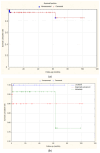The Clinicopathological Characteristics and Surgical Treatment of Gastrointestinal Neuroendocrine Neoplasm-A 10-Year Single-Center Experience
- PMID: 39201037
- PMCID: PMC11355324
- DOI: 10.3390/jcm13164892
The Clinicopathological Characteristics and Surgical Treatment of Gastrointestinal Neuroendocrine Neoplasm-A 10-Year Single-Center Experience
Abstract
Background: Gastrointestinal neuroendocrine neoplasms (GI-NENs) represent a diverse group of tumors, with surgical resection being the gold standard for treatment. Materials and Methods: A retrospective analysis was conducted on 63 patients (32 women, 31 men) who underwent surgery for GI-NENs at the Department of Digestive Tract Surgery from January 2013 to June 2023. Tumors were classified by stage (localized, regionally advanced, metastatic). Results: Clinical symptoms were reported by 42 (66.7%) patients, with abdominal pain being the most common symptom, affecting 28 (44.4%) patients. The majority of tumors (44, 69.8%) originated in the midgut. The most frequently performed surgery was right hemicolectomy, carried out on 33 (52.4%) patients. Radical tumor resection was performed in 35 (55.6%) patients. Postoperative complications occurred in 12 (19%) patients, with male gender identified as an independent predictive factor for complications (p = 0.04). Non-functioning tumors were more common (33, 52.4%), and most tumors were classified as grade 1 histopathologically (49, 77.8%). Distant metastases were present in 29 (46%) patients. The overall two-year survival rate was 94.9%, with a five-year survival rate also estimated at 94.9%. Conclusions: GI-NENs are often diagnosed at advanced stages, frequently with distant or lymph node metastases, and predominantly arise in the midgut. Despite low postoperative morbidity and mortality, male gender may be a predictor of postoperative complications. Overall, the prognosis for GI-NENs is favorable, reflected in high overall survival rates.
Keywords: gastrointestinal tract; neuroendocrine tumors; surgical treatment.
Conflict of interest statement
The authors declare no conflicts of interest.
Figures



Similar articles
-
Surgical treatment of intermediate to high grade thymic neuroendocrine neoplasms: case series of five patients and literature review.Transl Cancer Res. 2022 Oct;11(10):3535-3547. doi: 10.21037/tcr-22-1150. Transl Cancer Res. 2022. PMID: 36388024 Free PMC article.
-
[Prognostic analysis and clinicopathological features of 20 patients with appendiceal neuroendocrine neoplasms].Zhonghua Wei Chang Wai Ke Za Zhi. 2018 May 25;21(5):564-568. Zhonghua Wei Chang Wai Ke Za Zhi. 2018. PMID: 29774940 Chinese.
-
[Analysis of clinicopathological characteristics, therapeutic strategy and prognosis of 501 patients with gastric neuroendocrine neoplasms attending a single center].Zhonghua Wei Chang Wai Ke Za Zhi. 2023 May 25;26(5):459-466. doi: 10.3760/cma.j.cn441530-20220512-00212. Zhonghua Wei Chang Wai Ke Za Zhi. 2023. PMID: 37217354 Chinese.
-
Hepatic surgery for metastases from neuroendocrine tumors.Surg Oncol Clin N Am. 2003 Jan;12(1):231-42. doi: 10.1016/s1055-3207(02)00076-5. Surg Oncol Clin N Am. 2003. PMID: 12735141 Review.
-
Role of Advanced Gastrointestinal Endoscopy in the Comprehensive Management of Neuroendocrine Neoplasms.Cancers (Basel). 2023 Aug 19;15(16):4175. doi: 10.3390/cancers15164175. Cancers (Basel). 2023. PMID: 37627203 Free PMC article. Review.
References
LinkOut - more resources
Full Text Sources

